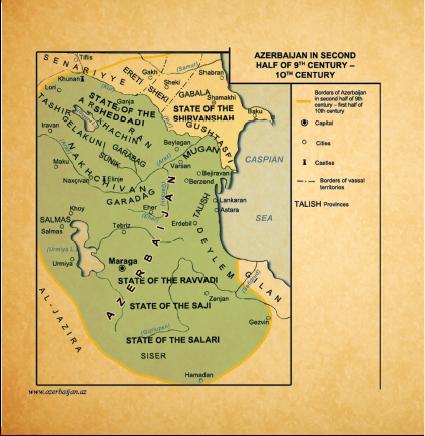 The Ravvadid state played an important role in the history of Azerbaijan for about one century since the end of the 10th century (983-1060 and 1107-1177) in the south of Azerbaijan. During the decline of the Salarid state circa 950s, Muhammad ibn Hussein, a representative of the Ravvadid dynasty seized some lands of Azerbaijan. In 956-957, he conquered Tabriz and its neighborhood. The wars culminating in the end of the 970s ended with the victory of Abulheija, son of Hussein over the Salarid ruler Ibrahim. Abulheija also succeeded in conquering the Salarid lands south to the River Arax and incorporated them to his possessions. During the marches of the Seljuqs to the Southern Caucasus, the territory of Ravvadid covered the entire Southern Azerbaijan. Upon the siege of Tabriz by the Seljuq Sultan Toghrul in 1060, Mamlan II declared himself a subject of Sultan. After losing their political power, the Ravvadids could not regain their might. Only 1107-1108 sources mention the ruler of Maragha Ahmadili ibn Ibrahim ibn Wahsudan ar-Ravvadid, who took control over the south-western lands of Azerbaijan. Following the murder of Ahmadili in the Caliph`s court in Baghdad in 1116-1117, the Ravvadid dynasty was wiped off history. Its capitals were Tabriz and Maragha.
The Ravvadid state played an important role in the history of Azerbaijan for about one century since the end of the 10th century (983-1060 and 1107-1177) in the south of Azerbaijan. During the decline of the Salarid state circa 950s, Muhammad ibn Hussein, a representative of the Ravvadid dynasty seized some lands of Azerbaijan. In 956-957, he conquered Tabriz and its neighborhood. The wars culminating in the end of the 970s ended with the victory of Abulheija, son of Hussein over the Salarid ruler Ibrahim. Abulheija also succeeded in conquering the Salarid lands south to the River Arax and incorporated them to his possessions. During the marches of the Seljuqs to the Southern Caucasus, the territory of Ravvadid covered the entire Southern Azerbaijan. Upon the siege of Tabriz by the Seljuq Sultan Toghrul in 1060, Mamlan II declared himself a subject of Sultan. After losing their political power, the Ravvadids could not regain their might. Only 1107-1108 sources mention the ruler of Maragha Ahmadili ibn Ibrahim ibn Wahsudan ar-Ravvadid, who took control over the south-western lands of Azerbaijan. Following the murder of Ahmadili in the Caliph`s court in Baghdad in 1116-1117, the Ravvadid dynasty was wiped off history. Its capitals were Tabriz and Maragha.

